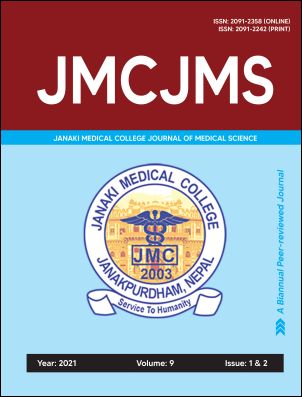Outburst of Food Poisoning among Hostellers of Certificate Level Nursing Students at Janaki Medical College, Dhanusha
DOI:
https://doi.org/10.3126/jmcjms.v10i2.47873Keywords:
Food Poisoning, nursing, OutburstAbstract
Background & Objective: Food poisoning is the result of eating contaminated, spoiled or toxic food and frequently felt in our society. There are more than 250 food borne diseases. Some of them causes complications even to death. It is worldwide public health burden as well. Causative agents werebacterial, protozoal, possible chemicals and some confounders. This study aims to evaluate the causative agents and treat the patients with protocol in Emergency.
Material and Methods: A purposive descriptive observational study of food poisoning in Proficiency Certificate level Nursing students in Janaki Medical College was done. All students and staffs were under survey by admitting in the Emergency ward and maintaining the treatment in observational ward. Proper history taking, Physical examination and investigations were done. Knowledge, Attitude and Practices of causation, safety risk, control measure and prevention of food handling were sensed by valid questionnaires. Data were analyzed using SPSS version 20.0.
Results: All patients (n=51) were female of 20 districts. 92% cases were of emerging adults. BMR ranges 17.5-25. 83% cases were admitted in observational ward and 5.4% cases were self-limited. Clinical features were abdominal pain (70%), diarrhea (70%), fever with chills (70%), headache (52%), Nausea (35%) and vomiting (31%). Hemogram showed 52% cases were of leukocytosis. Neutrophilia (88%), lymphocytosis (52%), anaemia (46%), hypoglycemia(72%), hyponatraemia (16%) and hypernatraemia (6%).Stool RE/ME showed loose stool(100%), green(100%) in colour, mucoid (10%) consistency in physical examination while plenty of pus cell (100%), undigested food particle (40%), microscopic RBCs(20%), Entamoeba histolytica (10%) were seen in microscopic examination. Stool culture showed 80% cases were of pathogenic E.coli. and 10% cases were of shigella. Three cases were urine culture isolates with E. coli. Overall, questionnires to Knowledge, Attitude and Practices of food handling, safety and risk about food poisonings were found satisfactory.
Conclusion: The causative agents were EPEC (clinically), shigella dysentery and E. histolytica. The sensitivity patterns of antibiotics were of ceftriaxone, ciprofloxacine, meropenum, chloramphenicol, clindamycin, Piperacillin with Tazobactam. Overall assessment of Knowledge, Attitude and Practices about food handling, safety and risk factors were found satisfactory. The responsible departments were emphasized to take appropriate actions in specific way for further control and prevention of food poisoning.
Downloads
Downloads
Published
How to Cite
Issue
Section
License
© JMCJMS, JMC, Janakpur, Nepal




